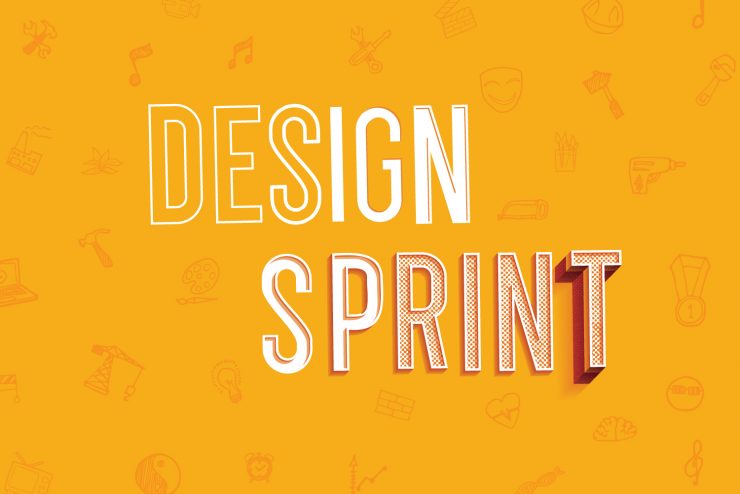It’s too obvious to make this a statement. But every business wishes its new product to succeed.
The product team envision their idea to make the revolution they aimed for. And everyone involved works striving towards this goal. They put their heart and soul into building this product. Imagine doing everything just to see it fail. Disheartening, isn’t it?
How to ensure that each of them (involved in ideation to execution) isn’t disappointed?
By not letting them put hope on an impractical idea.
How do you know the effectiveness and issues an idea poses?
By putting it through a validation process.
It’s better to find out the efficiency as soon as possible. That’s how the team advances to either proceed with the current idea or move on to the next one. While you lookout for a solution here, arrives design sprint, like a knight in armor.
Let’s dive into the blog to know-how.
What is a design sprint?
A successful product is more than its surface of colours, buttons, and features. For regular users, it becomes a source of emotional satisfaction as they rely on the product to complete a set of actions.
There is no single method of building products that can promise success.
Because, at the core, every product is based on a different idea.
Thus, knowing if your idea is really good and putting down the right processes, are challenges that can paralyze anyone.
Luckily, there is a method that can validate ideas and measure their market-feasibility: Design Sprint.
A design sprint is a 5-day, intensive process that tests new ideas by focusing on users’ needs and immediately confirming them through feedback.
Building a product takes a lot of patience and hard work, and a design sprint can tell you if all of your efforts will ultimately pay off.
Design Sprints and problem-solving
A design sprint specializes in solving problems in the most effective manner. Being rooted in design thinking also means that it can be applied to many fields and disciplines.
Commonly, a design sprint is highly useful when:
- You have a great idea and you want to see if it fits well in the market
- You want a stellar launch and want to minimize risks
- You want to match the actual needs of your customers
- You are doubtful about a certain aspect of your product
The last point is generally associated with complementary aspects, such as a brand’s tone or a website’s design.
Essentially, design sprints can be used to bring direction wherever there isn’t any since they elaborate vague ideas into proper, actionable steps.
Ultimately, design sprints shine with new and complex problems that have no previous solutions anywhere.
The design sprint as a concept has been floating around ever since ‘agile’ became a thing. But it was VCs at Google who gave it its form and insistence on user-feedback and validation.
Hence, this process is sometimes known as the Google Design Sprint.

Design Sprint: Origin
Sprints have been the cornerstone of the agile methodology from the beginning. It was just a matter of time before departments other than programming took notice of its capabilities and started using them.
Design Sprint is the culmination of all that ‘agile’ stands for. Instead of enabling just a single department, Design Sprint focuses on bringing together the whole organization and all of its cross-functional teams to solve a single problem.
Taking the concept of the sprint and extending it into problem-solving and iterative solution development started off at Google Ventures. Jake Knapp ran design sprints at Google starting in 2010 for products such as Chrome and Google Search.
After two years, he brought it to GV, where Braden Kowitz added story-centered design that carves the customer journey in no time.
As it says on GV, Design Sprint “is a “greatest hits” of business strategy, innovation, behavior science, design thinking, and more—packaged into a battle-tested process that any team can use.”
Overview of how a Design Sprint takes place
Inspired by the Google Design Sprint, an end-to-end session typically runs during an entire working week, i.e., it starts on Monday and ends on Friday.
Each day of this week produces its corresponding outcomes.
On Monday, the important problem (the target) is identified. The entire day is devoted to planning and to structure the other days so that everyone can focus on being completely productive.
On Tuesday, ideas are generated to solve problems and put down on sketches. Members are encouraged to find inspirations to kickstart the idea-generation process.
On Wednesday, the best solutions are chosen and put down into a single storyboard. Members get around the whiteboard and place each sketch and draw the necessary details to frame a proper story, that starts with the problem and ends with the solution.
On Thursday, tools are gathered, people are split into mini-teams, and the prototype is built.
On Friday, the customers are brought in and seated in the interview room. The interview puts the customer at ease and encourages them to use the prototype. In another room, the rest of the design-sprint team observes the customer.
The process is summarized below:

Each day starts at 10 am (except for Friday) and ends at 5 pm. An hour-long lunch break splits this six-hour day into two equal blocks of three hours— from 10 am to 1 pm, and from 2 pm to 5 pm.
Outcomes of a Design Sprint
The collective knowledge from the customer-reactions is the key to solving the problem that you and your team were facing at the beginning of the week.
Any gaps that the users face demand immediate thought and attention. And they also inform you enough to make the drastic decision of putting effort into an idea/product.
If the users struggled a lot while interacting with your product, then there are lots of gaps that need to be filled.
Whether or not the customers understood the actual intent of the product is important as well. If they misinterpret or entirely miss the point, then the goals set by your team are way off and need to be reconsidered.
If the users were purely delighted while they used the product, then you know what to do: Find what is being done right and make sure that those continue to happen.
Overall, if they had only slight moments of confusion while using your product, then it just shows that a little bit of realignment/readjustment will make you ready for launch.
Ultimately, a design sprint will arm every single team member with a lot of data and insights.
A design sprint shows :
- How a customer feels about a product
- This is ‘Acceptance’. If they like it, they would use it without hesitation.
- How likely a customer is to use a product on their own
- This is ‘Attraction’. They use the product because they love it. This drives adoption.
- How user-friendly a product is
- This is ‘Attention’. If the UI/UX is easy to understand and use, then they will continue to use the product. (Growth)
- How well does a product solve a problem
- This is ‘Aptitude’. If the product can predictably solve variations of the same problem without any gaps, then it stays in that market.
Based on these criteria, a well-informed decision on whether an idea should be pursued can be taken.
Advantages of a Design Sprint
Design sprints are what traditional customer-feedback processes aren’t: efficient, insightful, and actionable. Here is how.
Avoiding Groupthink
Bold ideas hardly shine in group settings.
Imagine a person talking about their new idea that they had a week ago. Another person would immediately jump in to respond to it. In a debate, this works well because both parties can spot flaws in each other’s arguments and improve through it.
Brainstorming sessions aren’t like formalized debates, as it very much focuses on generating ideas on the spot. Not discussing previously processed ideas.
Applying the same dynamics of the debate would neither allow the ideator to fully form their idea nor have an opposition that listens and learns in the process
Design Sprints eliminate that by encouraging every team member to research, think, and ideate individually.
Avoiding Bias
In group settings, ideas get judged by their source more than their actual practicality.
If the boss talks about a new idea that they have, then everyone pays attention and even agrees to think more about the idea.
But if a new idea were communicated by a newcomer, it might not be considered.
This is because the newcomer is perceived as a novice, and the boss is not.
Also because the boss pays the bills and thus agreeability is an obligation.
Design Sprints eliminate biases by making ideas and sketches completely anonymous. The focus stays on the quality and feasibility of the idea and not its source.
Putting Structure
Traditional brainstorming sessions have the barest of rules. There is a time when everyone is supposed to meet, along with an agenda.
But the overall processes of what should be thought upon and how the ideas will be reached are not framed.
As a rigorous set of processes, Design Sprints guide every aspect of the problem-solving session.
From setting a long-term vision to align everyone, to showing exactly how to remix a solution-strategy, a design sprint makes every step of the problem-solving session fast and replicable.
Putting a Diverse Team in action
Traditional planning occurs in silos.
If there is a hurdle with communicating a certain feature during the sales call, then only the sales team handles it.
Design Sprints tackle problems of all shapes and sizes. During one, a sales communication-gap would be solved by not just the sales rep, but the product owner, the CEO, and many others.
This diversification brings in several perspectives and solves the problem much faster.

Conclusion
The right choice makes all the difference.
For a business to make the right choice, frameworks and processes are needed.
One such is the design sprint process. With this decision-making is made a bit easy.
Now, you know what to do with ideas you doubted but can never let go of.
Set up a design sprint process. Test your innovative ideas that were at a halt. Who knows, it could turn out to be the finest idea and bring your business the success you wanted.
What are you waiting for? Let your ideas fly high.







Add comment